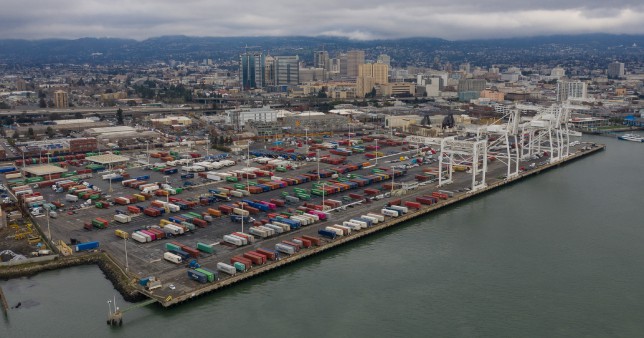Critics of the proposed location for an Oakland Athletics baseball stadium point to a study that says the Howard Terminal site will be needed for cargo.
Longshoremen and port businesses continue to oppose a proposal by the Oakland Athletics to build a baseball stadium on Port of Oakland property.
Scott Taylor, president and chief executive officer of GSC Logistics, asked the Oakland City Council Tuesday evening “to do everything you can to support this port.”
GSC is involved in port drayage, intrastate and interstate trucking as well as deconsolidation and transloading of cargo. Scott said GSC handles about 12% of the import merchandise at the Port of Oakland and “pours about $40 million into the Oakland economy” through wages.
Calling the port the “economic engine of Northern California,” he said the port supports thousands of jobs, with drivers earning more than $100,000 and warehouse workers making $50,000.
“These are not peanut vendor jobs, these are not hot dog vendor jobs,” he said.
Taylor pointed to a Bay Area Seaport Forecast prepared by the consultants Tioga Group and Hackett Associates for the San Francisco Bay Conservation and Development Commission (BCDC), which is updating its seaport plan to forecast through 2050 future needs for throughput marine cargo through the San Francisco Bay region’s ports and the throughput capacity of the ports.
The report includes an appendix on the potential role of the Charles P. Howard Terminal, where the Oakland Athletics want to build a baseball stadium.
That study said the 50-acre Howard Terminal site “is below the current standard for new container terminals but may be a necessary increment to seaport capacity under moderate-to-strong cargo growth scenarios.” The stadium site could be reduced to 40 acres because of plans to remove part of the shoreline so that a turning basin for ships in the Oakland estuary can be expanded to accommodate the larger ships calling at the port’s container terminals.
“Under a moderate-growth scenario with sufficient productivity increases, the Bay Area could have sufficient container cargo capacity through 2050 without Howard Terminal, but would be at or near capacity (estimated at 99.8%) with little or no room for future growth. Under a strong-growth scenario, Oakland is expected to need Howard’s acreage by around 2042,” the study said.
The report said the terminal site also could be used for roll-on, roll-off cargo, especially for exports of cars made by Tesla or another manufacturer, or even for bulk cargo.
Andres Garcia, the chairman of GSC, complained the plan for the stadium is being pushed by Oakland Mayor Libby Schaaf and appears to be a fait accompli.
“Short of having construction equipment at Howard Terminal, everything is pointing to the fact that it is going to happen whether you like it or not,” Garcia said. “There has to be some fairness.”
Under a 1965 law called the McAteer-Petris Act, the BCDC has regulatory authority over filled- in portions of San Francisco Bay and limits that activity to water-oriented uses. Portions of the Howard Terminal are built on fill, and the law says BCDC should authorize projects on bay fill only when no alternative upland location is available.
But the BCDC “can alternatively find that certain activities are necessary for the health, safety and welfare of the public in the entire San Francisco Bay area,” says a bill (AB 1191) currently before the California Legislature. The bill would authorize the BCDC to approve the ballpark if various conditions are met.
Weston LaBar, CEO of the Harbor Trucking Association, said, “We have some very serious concerns about safety and traffic” as well as health issues about the port location.
The Oakland Athletics has said it plans to develop 3.3 million square feet of housing, 1.5 million square feet of commercial and office space, a hotel and a performance center in the area surrounding the stadium.
Rebecca Kaplan, Oakland City Council president, emphasized that the council has not approved the ballpark at Howard Terminal and that the comments it has heard will be considered.
Large numbers of workers from the International Longshore and Warehouse Union opposed to the proposed facility, as well as sports fans who support the stadium, spoke before the City Council Tuesday. Two of Oakland’s professional teams are in the process of moving out of the city: the Golden State Warriors to a new basketball arena in San Francisco and the Oakland Raiders to Las Vegas.
Many opponents argued the new ballpark should be built near the team’s current home, the Oakland Coliseum in East Oakland, which has substantial parking and access to the Bay Area Rapid Transit system.
Max Alper, an officer of the Marine Engineers Beneficial Association, said the “Oakland Coliseum works. Do they need a new stadium? Yes. Do they need to move it to Howard Terminal? Absolutely not. If they put a good team on the field, people will show up and watch them play. They don’t have a location problem.”











